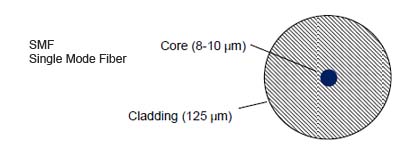|
|
|
SMF - Single Mode Fiber
Over View An optical fiber is a single, hair-fine filament drawn
from molten silica glass. These fibers are often used as the
transmission medium in high-speed, high-capacity communications systems
that convert information into light, which is then transmitted via fiber
optic cable. Optical fiber is composed of three key elements: Core,
Cladding and Coating. The core is the innermost part of the fiber
through which light pulses are guided. Cladding surrounds the core to
keep light in the center of the fiber. The core and cladding are
inseparable layers of glass. The coating is a layer of polymer that
surrounds the cladding to protect the glass. Optical fiber cable may be Single Mode Fiber Due primarily to the small core size, SMF requires high end
lasers and precise components, which typically result in overall higher
system costs. However, the distance and bandwidth capabilities make SMF the
primary choice for long haul networks. Multimode fiber cables include the following:
|
